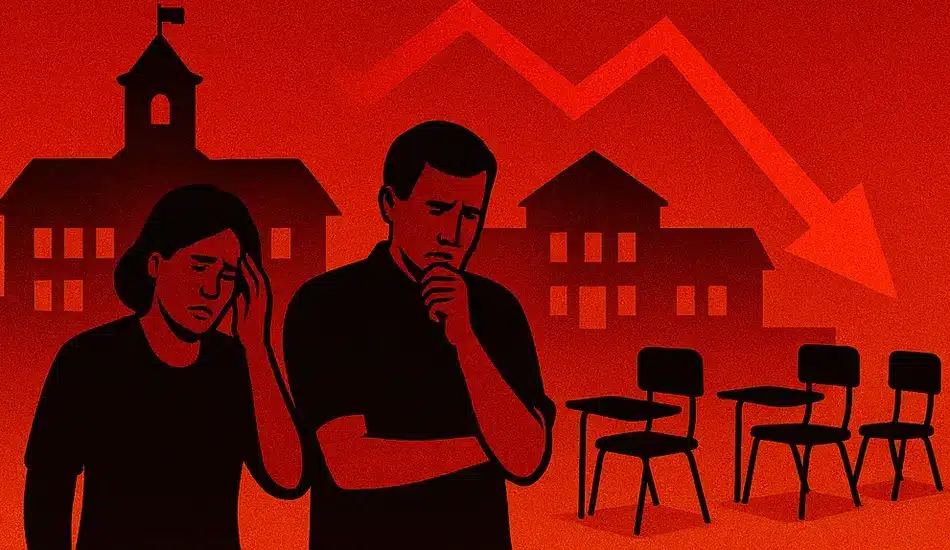Introduction: The Education Fiscal Cliff Crisis
The public school enrollment decline across the United States has created an unprecedented crisis in education funding, with approximately 250,000 education jobs worth $24 billion hanging in the balance. This public school enrollment decline has been steadily occurring over the past five years, but the expiration of pandemic-era ESSER funds has exposed the true magnitude of the problem, creating what experts call a “fiscal cliff” for school districts nationwide.
The public school enrollment decline has serious implications for how states fund education, as most funding models are based on student enrollment numbers. With fewer students to serve, districts need fewer teachers and staff, but the sudden loss of federal relief money has left many schools struggling to maintain their current staffing levels while facing significant budget shortfalls.
The Perfect Storm: Declining Enrollment Meets Funding Expiration
Understanding the Public School Enrollment Decline
The public school enrollment decline in the United States has been a gradual but persistent trend since 2020, with California experiencing even steeper declines than the national average. This public school enrollment decline is driven by two primary factors that have created a perfect storm for education funding.
The first and most significant factor contributing to the public school enrollment decline is lower birth rates across the country. Fewer children are being born, which naturally leads to smaller kindergarten and first-grade classes. While this demographic shift hasn’t yet affected high school enrollment significantly, it’s creating a cascading effect that will impact all grade levels in the coming years.
The second factor affecting the public school enrollment decline is migration patterns, particularly in states like California. Historically, California has been a net migration destination, but during the pandemic, this pattern shifted between net migration in and out of the state. The state has not been able to offset declining birth rates with migration from other states, further exacerbating the public school enrollment decline.
The ESSER Funding Crisis
The public school enrollment decline was already occurring in some states before the pandemic, but an influx of federal relief money temporarily obscured the financial decline. The federal government provided substantial ESSER (Elementary and Secondary School Emergency Relief) funds to school districts during the pandemic and recovery period, injecting billions of dollars into education systems that typically rely on state and local funding.
This federal money was distributed regardless of enrollment numbers, focusing instead on helping students return to school after pandemic-related closures and addressing unusual expenses that districts faced during the crisis. Many school districts used these funds to add essential services for students, including learning recovery programs, social and emotional learning support, and additional staff to provide these services.
However, when the ESSER funds expired in September 2024, it exposed the unsustainable nature of many districts’ budgets. Districts that had been losing students for years but were propped up by federal money suddenly found themselves facing massive budget shortfalls. The public school enrollment decline combined with the loss of federal funding created what experts are calling “the bloodletting” of 2025.
The Impact on School Staffing and Budgets
The Staffing Dilemma
The public school enrollment decline means that schools require fewer staff and resources to serve their students, but it also directly impacts education budgets. In most states, school funding is based on how many students are enrolled, or in California’s case, how many students actually show up each day. Fewer students equal fewer dollars, creating a financial squeeze that many districts are struggling to manage.
Most school districts are reluctant to lay off staff or walk back pay raises, which creates gaps in their budgets. These budget gaps are occurring simultaneously with enrollment declines, putting tremendous pressure on school district budgets. The problem is particularly acute because many districts didn’t address the public school enrollment decline gradually over time as they normally would.
Traditionally, when districts face enrollment declines, they use attrition to gradually shrink their workforce, closing schools over several years and allowing natural turnover to reduce staffing levels. However, the availability of COVID relief money allowed districts to avoid making these difficult decisions for the past four to five years, leading to a situation where they now must reckon with all fiscal gaps at once.
The Pasadena Unified School District Case Study
The Pasadena Unified School District in Southern California provides a compelling example of how the public school enrollment decline is affecting school districts nationwide. PUSD has seen a steady decline in enrollment since 2014, mirroring the broader trend in California. The district announced in 2024 that they were considering staffing cuts due to budget shortfalls, with approximately 117 teachers being told they wouldn’t return the following year.
The district’s decision to implement layoffs has led to significant pushback from the community, with parents and teachers accusing the district of poor planning and misplaced priorities. Critics argue that teacher salaries represent only about 30% of the district’s entire budget, so cutting 10% of teachers only saves 3% overall, questioning the effectiveness of such cuts.
Jonathan Gardner, president of the United Teachers of Pasadena, emphasizes that the issue isn’t just about the numbers but how decisions are made. He points out that principals are being cut completely out of the decision-making process, and the people making the decisions are central office administrators who may not fully understand the impact on individual schools.
Hiring?
Post jobs for free with WhatJobs – Find qualified education professionals for your school district or organization. Whether you’re hiring teachers, administrators, or support staff, WhatJobs connects you with passionate educators ready to make an impact.
Post a Job for Free →The Broader Implications for Education
The Human Cost of Budget Cuts
The public school enrollment decline and resulting budget cuts are having devastating impacts on school morale and student well-being. As one community member noted, these layoffs are having “irreversible impacts on our students and their sense of what’s right in this world.” The education industry is inherently human-intensive, and laying off teachers, counselors, librarians, nurses, aides, and bus drivers goes against the core mission of education.
None of the professionals who entered education did so with the intention of laying off their colleagues. The layoff and reduction in force process is emotionally trying for everyone involved, from administrators making the decisions to teachers receiving layoff notices to students losing their educators.
The Need for Better Planning and Exit Strategies
The public school enrollment decline crisis has highlighted the importance of proper planning when using one-time funds. Many districts hired staff with ESSER funds without developing exit plans for when those funds expired. This lack of planning has left districts without breathing room when the funding ended.
Some districts, however, did implement better strategies. San Francisco Unified, for example, had 395 teacher layoff notices go out, but then provided a retirement incentive that allowed all 395 notices to be rescinded. This approach demonstrates that there are alternatives to mass layoffs when dealing with the public school enrollment decline.
Other districts have taken advantage of natural attrition, using retirements and voluntary departures to gradually reduce staffing levels without resorting to layoffs. This more gradual approach can help districts manage the transition more smoothly while minimizing the disruption to students and staff.
Looking Forward: Solutions and Strategies
The Importance of Program Evaluation
As districts face the public school enrollment decline and budget constraints, they may need to have difficult conversations about program priorities. Districts have been offering various services for years using different funding sources, and it may be time to reprioritize how existing funds are used.
This process requires districts to pause and evaluate all the programs they’re spending money on, determining which ones are actually moving the needle in the right direction for students. Shedding programs that have been around for years is a difficult process, especially when staff are tied to those programs, but it may be necessary to ensure the sustainability of essential educational services.
The Role of State and Federal Policy
The public school enrollment decline crisis also highlights the need for policy changes at the state and federal levels. The current funding models that tie education funding directly to enrollment numbers may need to be adjusted to account for the demographic shifts occurring nationwide.
Additionally, the federal government may need to consider extending or replacing the ESSER funding to help districts transition more smoothly through this period of public school enrollment decline. Without such support, many districts will continue to face difficult choices between maintaining essential services and balancing their budgets.
Conclusion: Navigating the Education Fiscal Cliff
The public school enrollment decline represents one of the most significant challenges facing American education in recent history. With 250,000 education jobs at risk and $24 billion in labor costs hanging in the balance, the stakes couldn’t be higher for students, teachers, and communities nationwide.
The combination of declining birth rates, migration patterns, and the expiration of pandemic relief funds has created a perfect storm that requires immediate attention from policymakers, educators, and communities. While the challenges are significant, there are solutions available, from better planning and exit strategies to program evaluation and policy changes.
As we navigate this education fiscal cliff, it’s essential to remember that the decisions made today will have lasting impacts on the quality of education for generations to come. The public school enrollment decline may be a demographic reality, but how we respond to it will determine the future of public education in America.
Frequently Asked Questions
What is causing the public school enrollment decline?
The public school enrollment decline is primarily caused by two factors: lower birth rates across the country, which means fewer children are being born, and changing migration patterns, particularly in states like California where net migration has shifted during the pandemic.
How does the public school enrollment decline affect education funding?
The public school enrollment decline directly impacts education funding because most states fund schools based on the number of students enrolled. Fewer students mean fewer dollars, creating budget shortfalls that force districts to make difficult decisions about staffing and programs.
What role did ESSER funding play in the public school enrollment decline crisis?
ESSER funding temporarily masked the public school enrollment decline by providing federal relief money regardless of enrollment numbers. When this funding expired in September 2024, it exposed the unsustainable nature of many districts’ budgets, creating what experts call a “fiscal cliff.”
How are school districts responding to the public school enrollment decline?
Districts are responding to the public school enrollment decline in various ways, from implementing layoffs to using attrition and retirement incentives. Some districts are also evaluating program priorities and considering which services to maintain or eliminate based on available funding.




